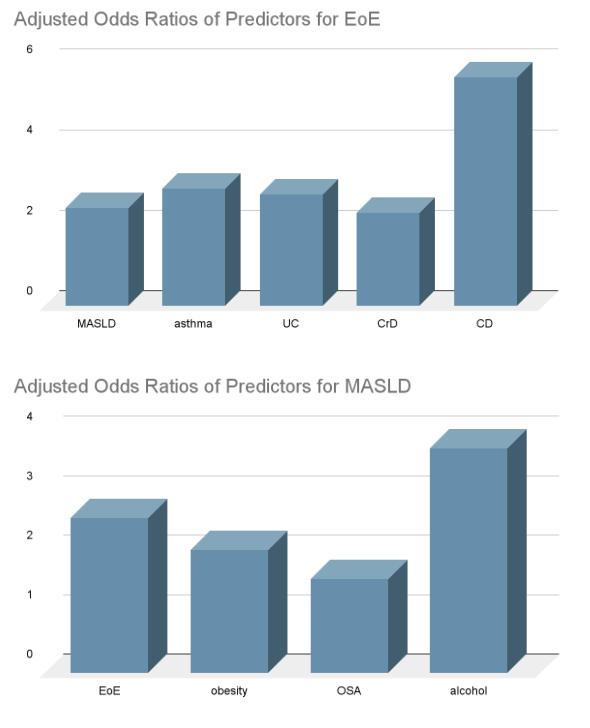Monday Poster Session
Category: Liver
P3716 - Eosinophilic Esophagitis and MASLD in US Inpatients: Exploring a Potential Clinical Link
Monday, October 27, 2025
10:30 AM - 4:00 PM PDT
Location: Exhibit Hall

Hima Varsha Voruganti, MD
North Alabama Medical Center
Florence, AL
Presenting Author(s)
Hima Varsha Voruganti, MD1, Rohit Sekandlapuram, MD2, Yeongjin Kim, MD1, Hamsika Moparty, MD3, Aashay Dharia, MD4, Manasa Ginjupalli, MD4, Rahul Karna, MD5
1North Alabama Medical Center, Florence, AL; 2The Brooklyn Hospital Center, Brooklyn, NY; 3Rutgers New Jersey Medical School, Brooklyn, NY; 4Brooklyn Hospital Center, Brooklyn, NY; 5University of Minnesota Medical Center, Minneapolis, MN
Introduction: Metabolic dysfunction-associated steatotic liver disease (MASLD) is strongly linked to components of metabolic syndrome, while eosinophilic esophagitis (EoE) has traditionally been viewed through an allergic or inflammatory lens. Although both conditions have individually seen rising prevalence, their potential intersection has not been thoroughly investigated. Using a large, nationally representative database, we sought to explore this potential association in hospitalized adults.
Methods: We analyzed adult hospitalizations (≥18 years) from the National Inpatient Sample (2018–2020). MASLD and EoE were identified using ICD-10-CM diagnosis codes. A multivariable survey-weighted logistic regression was performed to evaluate the association between EoE and MASLD, adjusting for demographics, hospital characteristics, Charlson Comorbidity Index, obesity, obstructive sleep apnea (OSA), diabetes, hypertension (HTN), hyperlipidemia (HLD), asthma, Crohn’s disease (CrD), ulcerative colitis (UC), celiac disease (CD), smoking, and alcohol use.
Results: Among 174,776,205 adult hospitalizations, an estimated 1,864,820 had MASLD and 31,550 had EoE. Among MASLD patients, those with EoE were younger (mean age 43.3 vs. 53.8 years) and had a similar sex distribution (female: 48.8% with EoE vs. 51.9% without; p = 0.42); however, racial distribution differed significantly (p = 0.0498), with a higher proportion of White individuals among those with EoE (77.9% vs. 65.8%). EoE was independently associated with higher odds of MASLD (OR 2.61; 95% CI: 2.21–3.08; p < 0.001). Other significant predictors included obesity (OR 2.07), OSA (OR 1.58), and alcohol use (OR 3.78). MASLD was significantly associated with increased odds of EoE (OR 2.45; 95% CI: 2.07–2.90; p < 0.001). Other conditions with strong positive associations included asthma (OR 2.91), UC (OR 2.78), CrD (OR 2.33), and CD (OR 5.68).
Discussion: This study demonstrates a significant association between metabolic dysfunction-associated steatotic liver disease (MASLD) and eosinophilic esophagitis (EoE) in hospitalized adults. These findings highlight the need for increased clinical awareness of potential comorbidities in patients with either condition.
Given the rising prevalence of both diseases, early recognition of their coexistence may support more coordinated care strategies. Further research into shared risk factors—such as metabolic dysfunction and systemic inflammation—may clarify underlying mechanisms and guide future therapeutic interventions.

Figure: Adjusted odd ratio for predictors of EoE and MASLD
Disclosures:
Hima Varsha Voruganti indicated no relevant financial relationships.
Rohit Sekandlapuram indicated no relevant financial relationships.
Yeongjin Kim indicated no relevant financial relationships.
Hamsika Moparty indicated no relevant financial relationships.
Aashay Dharia indicated no relevant financial relationships.
Manasa Ginjupalli indicated no relevant financial relationships.
Rahul Karna indicated no relevant financial relationships.
Hima Varsha Voruganti, MD1, Rohit Sekandlapuram, MD2, Yeongjin Kim, MD1, Hamsika Moparty, MD3, Aashay Dharia, MD4, Manasa Ginjupalli, MD4, Rahul Karna, MD5. P3716 - Eosinophilic Esophagitis and MASLD in US Inpatients: Exploring a Potential Clinical Link, ACG 2025 Annual Scientific Meeting Abstracts. Phoenix, AZ: American College of Gastroenterology.
1North Alabama Medical Center, Florence, AL; 2The Brooklyn Hospital Center, Brooklyn, NY; 3Rutgers New Jersey Medical School, Brooklyn, NY; 4Brooklyn Hospital Center, Brooklyn, NY; 5University of Minnesota Medical Center, Minneapolis, MN
Introduction: Metabolic dysfunction-associated steatotic liver disease (MASLD) is strongly linked to components of metabolic syndrome, while eosinophilic esophagitis (EoE) has traditionally been viewed through an allergic or inflammatory lens. Although both conditions have individually seen rising prevalence, their potential intersection has not been thoroughly investigated. Using a large, nationally representative database, we sought to explore this potential association in hospitalized adults.
Methods: We analyzed adult hospitalizations (≥18 years) from the National Inpatient Sample (2018–2020). MASLD and EoE were identified using ICD-10-CM diagnosis codes. A multivariable survey-weighted logistic regression was performed to evaluate the association between EoE and MASLD, adjusting for demographics, hospital characteristics, Charlson Comorbidity Index, obesity, obstructive sleep apnea (OSA), diabetes, hypertension (HTN), hyperlipidemia (HLD), asthma, Crohn’s disease (CrD), ulcerative colitis (UC), celiac disease (CD), smoking, and alcohol use.
Results: Among 174,776,205 adult hospitalizations, an estimated 1,864,820 had MASLD and 31,550 had EoE. Among MASLD patients, those with EoE were younger (mean age 43.3 vs. 53.8 years) and had a similar sex distribution (female: 48.8% with EoE vs. 51.9% without; p = 0.42); however, racial distribution differed significantly (p = 0.0498), with a higher proportion of White individuals among those with EoE (77.9% vs. 65.8%). EoE was independently associated with higher odds of MASLD (OR 2.61; 95% CI: 2.21–3.08; p < 0.001). Other significant predictors included obesity (OR 2.07), OSA (OR 1.58), and alcohol use (OR 3.78). MASLD was significantly associated with increased odds of EoE (OR 2.45; 95% CI: 2.07–2.90; p < 0.001). Other conditions with strong positive associations included asthma (OR 2.91), UC (OR 2.78), CrD (OR 2.33), and CD (OR 5.68).
Discussion: This study demonstrates a significant association between metabolic dysfunction-associated steatotic liver disease (MASLD) and eosinophilic esophagitis (EoE) in hospitalized adults. These findings highlight the need for increased clinical awareness of potential comorbidities in patients with either condition.
Given the rising prevalence of both diseases, early recognition of their coexistence may support more coordinated care strategies. Further research into shared risk factors—such as metabolic dysfunction and systemic inflammation—may clarify underlying mechanisms and guide future therapeutic interventions.

Figure: Adjusted odd ratio for predictors of EoE and MASLD
Disclosures:
Hima Varsha Voruganti indicated no relevant financial relationships.
Rohit Sekandlapuram indicated no relevant financial relationships.
Yeongjin Kim indicated no relevant financial relationships.
Hamsika Moparty indicated no relevant financial relationships.
Aashay Dharia indicated no relevant financial relationships.
Manasa Ginjupalli indicated no relevant financial relationships.
Rahul Karna indicated no relevant financial relationships.
Hima Varsha Voruganti, MD1, Rohit Sekandlapuram, MD2, Yeongjin Kim, MD1, Hamsika Moparty, MD3, Aashay Dharia, MD4, Manasa Ginjupalli, MD4, Rahul Karna, MD5. P3716 - Eosinophilic Esophagitis and MASLD in US Inpatients: Exploring a Potential Clinical Link, ACG 2025 Annual Scientific Meeting Abstracts. Phoenix, AZ: American College of Gastroenterology.
